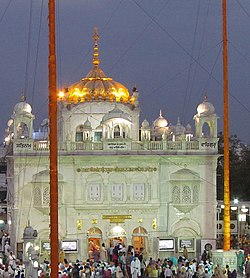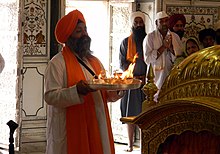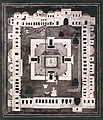| Sri Hazur Sahib | |
|---|---|
 The Hazur Sahib The Hazur Sahib | |
| General information | |
| Architectural style | Sikh architecture |
| Town or city | Nanded, Maharashtra |
| Country | |
| Coordinates | 19°09′10″N 77°19′07″E / 19.15278°N 77.31861°E / 19.15278; 77.31861 |
| Construction started | 1832 |
Hazur Sahib (Hazūrī Sāhib; lit. 'presence of the sahib/master'), also known as Takht Sachkhand Sri Hazur Abchalnagar Sahib, is one of the five takhts (religious centres) in Sikhism. The gurdwara (Sikh house of worship) was built between 1832 and 1837 by Maharaja Ranjit Singh (1780–1839). It is located on the banks of the Godavari River at the city of Nanded in the state of Maharashtra, India.
The structure is built at the place where Guru Gobind Singh Ji departed physical form and united with the eternal light. The gurdwara within the complex is known as Sach-Khand (Realm of Truth). The inner room of the gurdwara is called the Angitha Sahib and is built over the place where Gobind Singh was cremated in 1708.
History

Hazur Sahib marks the site where Guru Gobind Singh ji had his camp in 1708. The Guru held his court and congregation here and was convalescing after being attacked by two would-be assassins. One of the attackers stabbed the Guru, and was killed by him with a single stroke of his talwar (curved sword). The other was killed by his followers as he tried to escape. The Guru's wound was deep, but initially healed after being stitched by an English surgeon sent by Bahadur Shah I, who served as his doctor, and Dara Shikoh before him. However the wound re-opened a few days later when the Guru was stringing a bow for one of his Sikhs and the Guru merged into the Primal (Joti Jot) after declaring the Guru Granth Sahib as his successor.
The Sikhs built a room over the platform where Guru Gobind Singh Ji would sit while holding his court and installed Guru Granth Sahib Ji on it. They called it Takhat Sahib. Guru Gobind Singh Ji, while conferring Guruship to Guru Granth Sahib Ji, had himself named Nanded as "Abchalnagar" (literally "Steadfast city") after the first word of a hymn read at random on the occasion.
In October 2008, the 300th-anniversary celebration of the Guruship of Guru Granth Sahib ji took place here. This site is now one of five Takhats which are places of primary importance to the Sikhs. The other four takhats are: Sri Akal Takht Sahib at Amritsar, Takhat Sri Keshgarh Sahib at Anandpur, Takhat Sri Patna Sahib in Bihar and Takhat Sri Damdama Sahib in Talwandi Sabo, Bathinda, Punjab.
Sachkhand (literally "region of Truth") had been used by Guru Nanak Sahib Ji to mean the abode of God. Ranjit Singh had the present building of the Takhat Sahib constructed with money, artisans, and labor sent from Punjab during the early 1830s. Around the same time, the 3rd Nizam of Hyderabad Kingdom a Muslim ruler of the Deccan Region raised a contingent of Northern Sikhs as part of his army. Most of these men settled permanently in Hyderabad State and also few Hindus of the Deccan embraced Sikhism in the 19th century.
The control of Takhat Sachkhand Sri Hazoor Sahib, which had formerly passed into the hands of Udasi Sikh priests was regained by the Sikhs under the influence of the Singh Sabha Movement of the late nineteenth century. Some of the 'rituals and ceremonies connected with working' are peculiar to this Takhat Sahib. In 1956 an Act was passed by the legislature of Hyderabad under which the management of the Takhat Sahib and other historical Gurdwaras was legally placed under a 17-member Gurudwaras Board and a five-member Managing Committee.
The Takht houses both the Sri Guru Granth Sahib ji and the Sri Dasam Granth. This follows the pattern of Takht Sri Patna Sahib.
Nanded is the city where Baba Banda Singh Bahadur had his ashram and Baba Banda Singh started his journey of Khalsa victory.
The shrine differs from other historical places of Sikh worship, here all ancient customs which were practised at the time of the Guru are still practiced, for example, sandal-wood tilak is still applied on the foreheads of priests and local devotees.
While all the functions are carried out by the priests in the outer room, the inner room is a vault that houses valuable objects, weapons and other personal belongings of the Guru. No one except the head priest can enter the vault.
Heritage conservation
Sikh historians and scholars have raised alarms regarding the plight of Sikh historical heritage within the Takht Hazur Sahib complex. Many historical structures have been destroyed by the takht's management committee, much to the dismay of a vocal section of Sikhs who pleaded for these sites to be preserved in their original state. Sharad Chalikwar, a consultant engineer, and Kiran Kalamdani, a restoration architect, had come up with restoration plans to save the historical buildings but Hazur Sahib's management committee ended-up demolishing the buildings under the guise of Kar Seva renovations.
The buildings that were destroyed include:
- Ramgarhia Bunga, constructed upon the patronage of Maharaja Ranjit Singh. Demolished in January 2007.
- Baradari, constructed upon the patronage of Maharaja Ranjit Singh. Demolished in October 2007.
The gurdwara management committee, specifically chairman P.S. Pasricha, defended their action to destroy the historical sites because of their age, dilapidated condition, need for "beautification", needing room for their development plans, and that land has been allotted for the building of a new 31-room sarai with a museum.

300th anniversary celebrations
In 2008, the 300th Gurudomship ceremony of Guru Granth Sahib and 300th Joti Jot anniversary of Guru Gobind Singh were celebrated on a large scale at Hazoor Sahib, Nanded. Manmohan Singh, then Prime Minister of India, addressed the Sath-Sangat at the main function.
Laser fountain show

A laser show at Gobind Bagh near the main gurdwara briefly describes the lives of the ten Gurus. It is the second largest laser show in Asia.
Historical gurdwaras in Nanded

- Gurdwara Nagina Ghat Sahib
- Gurdwara Banda Ghat Sahib (Baba Banda singh Bahadur)
- Gurdwara Shikaar Ghat Sahib
- Gurdwara Baoli Sahib (Nr. GURU Gobind singh Museum)
- Gurdwara Heera Ghat
- Gurdwara Mata Sahib
- Gurdwara Maal Tekdi
- Gurdwara Sangat Sahib
- Gurdwara Damdama Sahib (Basmat Nagar, Parbhani)
- Gurdwara Nanakpuri Sahib (place of Guru Nanak)
- Gurudwara Bhajangarh Saheb
List of Jathedars
| This list is incomplete; you can help by adding missing items. (September 2023) |
| No. | Name | Term Start: | End | Reference(s) |
|---|---|---|---|---|
| 1. | Bhai Santokh Singh | 1708 | 1715 | |
| 2. | Bhai Khushal Singh | 1715 | 1722 | |
| 3. | Bhai Laal Singh | 1722 | 1730 | |
| 4. | Bhai Bakhtawar Singh | 1730 | 1736 | |
| 5. | Bhai Charat Singh | 1736 | 1786 | |
| 6. | Bhai Mohar Singh | 1786 | 1793 | |
| 7. | Bhai Ram Singh | 1793 | 1804 | |
| 8. | Bhai Dharam Singh | 1804 | 1812 | |
| 9. | Bhai Charat Singh | 1812 | 1817 | |
| 10. | Bhai Sahib Singh | 1817 | 1818 | |
| 11. | Bhai Aaya Singh | 1818 | 1824 | |
| 12. | Bhai Jassa Singh | 1824 | 1839 | |
| 13. | Bhai Isher Singh | 1839 | 1841 | |
| 14. | Bhai Waryam Singh | 1841 | 1844 | |
| 15. | Bhai Tara Singh | 1844 | 1858 | |
| 16. | Bhai Attar Singh | 1858 | 1867 | |
| 17. | Bhai Prem Singh | 1867 | 1875 | |
| 18. | Bhai Deva Singh | 1875 | 1876 | |
| 19. | Bhai Brij Singh | 1876 | 1877 | |
| 20. | Bhai Jawahar Singh | 1877 | 1883 | |
| 21. | Bhai Nanu Singh | 1883 | 1890 | |
| 22. | Bhai Maan Singh | 1890 | 1913 | |
| 23. | Bhai Daya Singh | 1913 | 1914 | |
| 24. | Bhai Hari Singh | 1914 | 1919 | |
| 25. | Bhai Hira Singh | 1919 | 1945 | |
| 28. | Bhai Bahadur Singh | 1945 | 1946 | |
| 27. | Bhai Hira Singh | 1946 | 1950 | |
| 28. | Bhai Harnam Singh | 1950 | 1956 | |
| 29. | Baba Joginder Singh | 1956 | 1984 | |
| 30. | Baba Hazura Singh | 1984 | 12 January 2000 | |
| 31. | Baba Kulwant Singh | 12 January 2000 | Incumbent |
Kirtan Maryada Ragis at Hazur Sahib
Bhai Jagat Singh (1917–1978) was an eminent Ragi who did Seva at the Takhat from AD 1934 to 1978 (till death).
Gallery
-
 Cremation of Guru Gobind Singh at Nanded
Cremation of Guru Gobind Singh at Nanded
-
 Overhead map of Takht Sri Hazoor Sahib Gurdwara complex, ca.1870.
Overhead map of Takht Sri Hazoor Sahib Gurdwara complex, ca.1870.
-
 Photograph of Takht Hazur Sahib, ca.1880.
Photograph of Takht Hazur Sahib, ca.1880.
-
 Historical photograph of Sri Hazur Sahib, Nanded in 1895
Historical photograph of Sri Hazur Sahib, Nanded in 1895
See also
Notes
- Not to be confused with a building with the same name located near the Golden Temple in Amritsar.
- Also spelt as Hazoor Sahib.
References
- Singh, S. Harpal (29 December 2019). "Guru Nanak's centuries-old link with Nizam's Nirmal". The Hindu.
- "ऐतिहासिक दसरा पर्वाची गुरुद्वारात जय्यत तयारी" [Aitihāsika Dasarā Parvācī Gurudvārāta Jayyata Tayārī]. Sakal (in Marathi). Nanded. 27 September 2011. Archived from the original on 24 September 2015. Retrieved 23 May 2015.
- "European Surgeon who Attended Satguru Gobind Singh in 1708".
- G.S., Randhir (1990). Sikh shrines in India. New Delhi: The Director of Publication Division, Ministry of Information and Broadcasting, Government of India.
- "The Tribune - Windows - Sites and Scenes".
- ^ Dogra, Chander Suta (3 May 2016). "Have You the Eyes for It?". SikhNet (republished, originally published by Outlook Magazine). Retrieved 21 September 2023.
Further reading
- Nidar Singh Nihang and Parmjit Singh, In the Master's Presence - The Sikhs of Hazoor Sahib, Kashi House (2009), ISBN 978-0-9560168-0-5.
